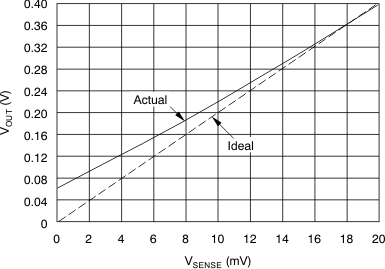JAJSEI7E February 2007 – January 2018 INA270 , INA271
PRODUCTION DATA.
- 1 特長
- 2 アプリケーション
- 3 概要
- 4 改訂履歴
- 5 Device Comparison Table
- 6 Pin Configuration and Functions
- 7 Specifications
- 8 Detailed Description
- 9 Application and Implementation
- 10Power Supply Recommendations
- 11Layout
- 12デバイスおよびドキュメントのサポート
- 13メカニカル、パッケージ、および注文情報
8.4.2.3 Low VSENSE Case 1: VSENSE< 20 mV, –16 V ≤ VCM< 0; and Low VSENSE Case 3: VSENSE< 20 mV,
VS< VCM ≤ 80 V
Although the INA270 family of devices are not designed for accurate operation in either of these regions, some applications are exposed to these conditions. For example, when monitoring power supplies that are switched on and off while VS is still applied to the INA270 or INA271, knowing what the behavior of the devices is in these regions is important.
When VSENSE approaches 0 mV, in these VCM regions, the device output accuracy degrades. A larger-than-normal offset can appear at the current shunt monitor output with a typical maximum value of VOUT = 60 mV for VSENSE = 0 mV. When VSENSE approaches 20 mV, VOUT returns to the expected output value with accuracy as specified in the Electrical Characteristics. Figure 17 shows this effect using the INA271 (gain = 20).
